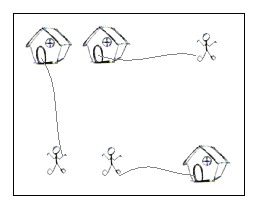Going Home
| Time Limit: 1000MS | Memory Limit: 65536K | |
| Total Submissions: 13981 | Accepted: 7156 |
Description
On a grid map there are n little men and n houses. In each unit time, every little man can move one unit step, either horizontally, or vertically, to an adjacent point. For each little man, you need to pay a $1 travel fee for every step he moves, until he enters a house. The task is complicated with the restriction that each house can accommodate only one little man.
Your task is to compute the minimum amount of money you need to pay in order to send these n little men into those n different houses. The input is a map of the scenario, a '.' means an empty space, an 'H' represents a house on that point, and am 'm' indicates there is a little man on that point.

You can think of each point on the grid map as a quite large square, so it can hold n little men at the same time; also, it is okay if a little man steps on a grid with a house without entering that house.
Your task is to compute the minimum amount of money you need to pay in order to send these n little men into those n different houses. The input is a map of the scenario, a '.' means an empty space, an 'H' represents a house on that point, and am 'm' indicates there is a little man on that point.

You can think of each point on the grid map as a quite large square, so it can hold n little men at the same time; also, it is okay if a little man steps on a grid with a house without entering that house.
Input
There are one or more test cases in the input. Each case starts with a line giving two integers N and M, where N is the number of rows of the map, and M is the number of columns. The rest of the input will be N lines describing the map. You may assume both N and M are between 2 and 100, inclusive. There will be the same number of 'H's and 'm's on the map; and there will be at most 100 houses. Input will terminate with 0 0 for N and M.
Output
For each test case, output one line with the single integer, which is the minimum amount, in dollars, you need to pay.
Sample Input
2 2 .m H. 5 5 HH..m ..... ..... ..... mm..H 7 8 ...H.... ...H.... ...H.... mmmHmmmm ...H.... ...H.... ...H.... 0 0
Sample Output
2 10 28
Source
二分图最大权值匹配。
用来练习模板的。
/* POJ 2195 求最小权值匹配 G++ 744K 0MS */ #include<stdio.h> #include<iostream> #include<string.h> #include<algorithm> #include<math.h> using namespace std; //************************************* //最大权匹配模板(KM算法) O(m*m*n) //邻接矩阵形式,返回最佳匹配值,传入二分图大小m,n //邻接矩阵g,表示权值 //match1,match2返回一个最佳匹配,未匹配顶点match值为-1 //一定注意 m<=n 否则循环无法终止 //最小权匹配可将权值取相反数 //初始化 // for(i=0;i<MAXN;i++) // for(j=0;j<MAXN;j++) g[i][j]=-INF; //对于存在的边 g[i][j]=val; const int MAXN=120; const int INF=0x3fffffff; int g[MAXN][MAXN],match1[MAXN],match2[MAXN]; int KM(int m,int n) { int i,j,k,p,q; int l1[MAXN],l2[MAXN]; int s[MAXN],t[MAXN]; int ret=0; for(i=0;i<m;i++) { l1[i]=-INF; for(j=0;j<n;j++) if(g[i][j]>l1[i]) l1[i]=g[i][j]; if(l1[i]==-INF) return -1;//无法匹配 } for(i=0;i<n;i++)l2[i]=0; memset(match1,-1,sizeof(match1)); memset(match2,-1,sizeof(match2)); for(i=0;i<m;i++) { memset(t,-1,sizeof(t)); for(s[p=q=0]=i;p<=q&&match1[i]<0;p++) for(k=s[p],j=0;j<n&&match1[i]<0;j++) if(l1[k]+l2[j]==g[k][j]&&t[j]<0) { s[++q]=match2[j],t[j]=k; if(s[q]<0) for(p=j;p>=0;j=p) match2[j]=k=t[j],p=match1[k],match1[k]=j; } if(match1[i]<0) { for(i--,p=INF,k=0;k<=q;k++) for(j=0;j<n;j++) if(t[j]<0&&l1[s[k]]+l2[j]-g[s[k]][j]<p) p=l1[s[k]]+l2[j]-g[s[k]][j]; for(j=0;j<n;j++)if(t[j]>=0)l2[j]+=p; for(k=0;k<=q;k++)l1[s[k]]-=p; } } for(i=0;i<m;i++) { if(match1[i]<0)return -1;//无法匹配 if(g[i][match1[i]]<=-INF)return -1; ret+=g[i][match1[i]]; } return ret; } //*********************************************** struct Node { int x,y; }; Node node1[MAXN],node2[MAXN]; char str[MAXN]; int main() { //freopen("in.txt","r",stdin); //freopen("out.txt","w",stdout); int n,m; int nx,ny; while(scanf("%d%d",&n,&m)!=EOF) { if(n==0&&m==0)break; nx=0; ny=0; for(int i=0;i<n;i++) { scanf("%s",&str); for(int j=0;j<m;j++) { if(str[j]=='m') { node1[nx].x=i; node1[nx].y=j; nx++; } else if(str[j]=='H') { node2[ny].x=i; node2[ny].y=j; ny++; } } } for(int i=0;i<nx;i++) for(int j=0;j<ny;j++) { g[i][j]=-abs(node1[i].x-node2[j].x)-abs(node1[i].y-node2[j].y); } printf("%d\n",-KM(nx,ny)); } return 0; }